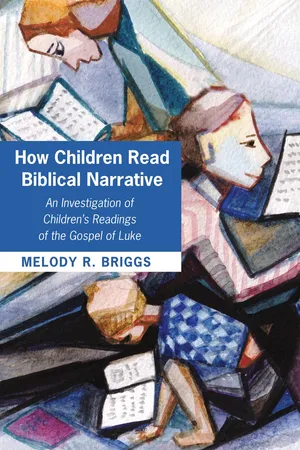![]()
Part One
The Theoretical Background to the Children’s Readings of Luke
![]()
Chapter 1
Introduction
The Question
How do children read the Bible? This is a question that does not often seem to come up in the circles where children and the Bible generally mix. The two key formal institutions in Britain that include these circles are the church and school, and their concern often appears to be determining what child readers ought to take from the biblical text, rather than asking the more basic question of what happens when the Bible and child meet, free of any imposed oughts. Even if these oughts, or boundaries, are necessary (and I am not certain that they are), how can we accurately draw the boundary lines if we have not first worked out the location of the field?
This study seeks to locate that field. It does not ask if children should be reading the Bible, but, rather, what happens when they do? This question should undergird the encounters between the Bible and the child that are initiated by the adults of any institution. It allows these adults to be more effective in their work with children and the Bible since it enables them to know their starting point. Importantly, this question also respects the child. As this study will show, children may well bring their own orientations and reading strategies to the biblical text. If we respect the position of children as people with a particular set of developmental interests and contextual concerns, and if we respect the Bible with its challenging and often subversive approach to the interests and concerns of any group, then we need to give child readers a voice to articulate their readings of the Bible. How else will we get a glimpse of the field?
This question matters because children, and especially churched children, are repeatedly exposed to the Bible not only in church-based groups and school, but also at home and through various forms of media. If these various parties are to handle the biblical text wisely with their young charges, they need to understand what young readers make of the Bible. It may be salutary at this point to provide a few examples of the clash between adult provision of the Bible and children’s expectations. One of the child participants in this study, Robyn, found herself reading through the Gospel of Luke at the same time as, but independently of, her church: “My church is reading Luke’s Gospel [for Lent] and I just assumed that when the church would read a whole Gospel, that they’d read the entire thing. When I finished Luke . . . I realized that they were missing verses out and how much that I hadn’t known.” Robyn responded with indignation to her discovery that her church was not exposing her to the entirety of the Gospel. She particularly bemoaned her church’s omission of what she deemed to be some of the most interesting parables: “They missed the Widow and the Judge out.” This discovery led her to an unsettling conclusion: “So now I realize how much the church doesn’t teach you.”
Note that Robyn’s discovery took place in the midst of an adult congregation. It was not in a children’s group where the Bible tends to be even more truncated and tamed. Another participant in this study, Trevor, lamented the discrepancy between the portrait of Jesus provided by Luke and the view of Jesus that he had developed through attendance at his church’s children’s work: “I found there was a lot of contradiction between what’s been drummed into me for ages at church, like, ‘Jesus was amazing. Jesus was perfect.’ Then what I’ve read in Luke, it’s really different.” This discrepancy left Trevor questioning his church tradition. The views expressed by Robyn and Trevor may perhaps not be views that the average churched adult would like children to have of their church’s handling of the Bible, but they may be unavoidable if children’s perspectives on the biblical text are not taken seriously.
Developing the Question
It would be misleading to present my study as the product of a self-evident research question that generated a particular way of investigating children’s readings of the Bible. I will now give a brief account of how my central question, “how do children read the Bible?” led to the development and shape of this study. Robyn and Trevor’s views resonate with me. Professionally, I straddle two academic disciplines: youth and children’s work as an area of practical theology, and biblical studies. I have found that the material and methods used in the former discipline in its approach to the Bible often diverge from the hermeneutical theories and interpretive methods advocated by the discipline of biblical studies. This divergence raised an array of related questions for me. Is it appropriate? Do the disciplines of practical theology, particularly the area of youth and children’s work, and biblical studies not have more to say to each other? What are the implications of this divergence for the children and youth with whom I have worked, as well as for the students whom I have trained to work with them?
It seemed to me that asking how children read the Bible might draw these two disciplines together, since analyzing the encounter of a real reader with the biblical text would overlap the interests of both. An area within biblical studies that particularly interests me is how ordinary readers handle the Bible, and children are one sub-group of these non-theologically trained readers. My central question has been largely neglected by the academy: biblical scholars have shown only minimal interest in the reading strategies of ordinary readers in general, let alone in those of children. A key exception here is the burgeoning interest in Contextual Bible Study with particular people groups.
My research in the discipline of children’s lit...
